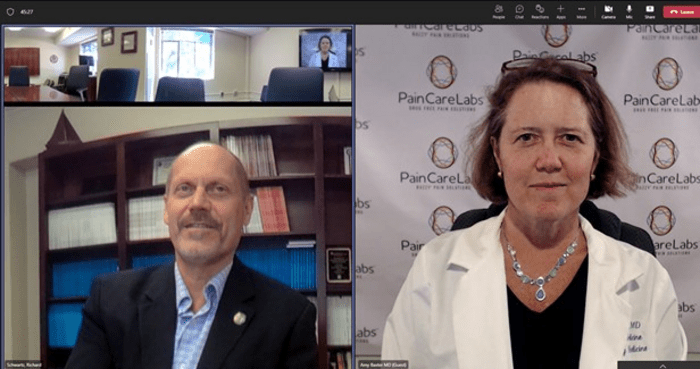AUGUSTA, Ga. (Sept. 13, 2022) – Starting twice daily flushing of the mucus-lined nasal cavity with a mild saline solution soon after testing positive for COVID-19 can significantly reduce hospitalization and death, investigators report.
They say the technique that can be used at home by mixing a half teaspoon each of salt and baking soda in a cup of boiled or distilled water then putting it into a sinus rinse bottle is a safe, effective and inexpensive way to reduce the risk of severe illness and death from coronavirus infection that could have a vital public health impact.
“What we say in the emergency room and surgery is the solution to pollution is dilution,” says Dr. Amy Baxter, emergency medicine physician at the Medical College of Georgia at Augusta University and corresponding author of the study in Ear, Nose & Throat Journal.
“By giving extra hydration to your sinuses, it makes them function better.
If you have a contaminant, the more you flush it out, the better you are able to get rid of dirt, viruses and anything else,” says Baxter.
“We found an 8.5-fold reduction in hospitalizations and no fatalities compared to our controls,” says senior author Dr. Richard Schwartz, chair of the MCG Department of Emergency Medicine. “Both of those are pretty significant endpoints.”
The study appears to be the largest, prospective clinical trial of its kind and the older, high-risk population they studied — many of whom had preexisting conditions like obesity and hypertension — may benefit most from the easy, inexpensive practice, the investigators say.
They found that less than 1.3% of the 79 study subjects age 55 and older who enrolled within 24-hours of testing positive for COVID-19 between Sept. 24 and Dec. 21, 2020, experienced hospitalization. No one died.
Among the participants, who were treated at MCG and the AU Health System and followed for 28 days, one participant was admitted to the hospital and another went to the emergency room but was not admitted.
By comparison, 9.47% of patients were hospitalized and 1.5% died in a group with similar demographics reported by the Centers for Disease Control and Prevention during the same timeframe, which began about nine months after SARS-CoV-2 first surfaced in the United States.
“The reduction from 11% to 1.3% as of November 2021 would have corresponded in absolute terms to over 1 million fewer older Americans requiring admission,” they write. “If confirmed in other studies, the potential reduction in morbidity and mortality worldwide could be profound.”
Schwartz says Baxter brought him the idea early in the pandemic and he liked that it was inexpensive, easy to use and could potentially impact millions at a time where, like other health care facilities, the Emergency Department of the AU Health System was starting to see a lot of SARS-CoV-2-positive patients.
“We were really looking at what options we had available for treatment,” Schwartz says. The first COVID-19 vaccines were given in December 2020 and the first treatment, the antiviral remdesivir was approved by the Food and Drug Administration in October 2020.
They knew that the more virus that was present in your body, the worse the impact, Baxter says. “One of our thoughts was: If we can rinse out some of the virus within 24 hours of them testing positive, then maybe we can lower the severity of that whole trajectory,” she says, including reducing the likelihood the virus could get into the lungs, where it was doing permanent, often lethal damage to many.
Additionally, the now-infamous spiky SARS-CoV-2 is known to attach to the ACE2 receptor, which is pervasive throughout the body and in abundance in locations like the nasal cavity, mouth and lungs. Drugs that interfere with the virus’ ability to attach to ACE2 have been pursued, and Baxter says the nasal irrigation with saline helps decrease the usual robust attachment. Saline appears to inhibit the virus’ ability to essentially make two cuts in itself, called furin cleavage, so it can better fit into an ACE2 receptor once it spots one.
Participants self-administered nasal irrigation using either povidone-iodine, that brown antiseptic that gets painted on your body before surgery, or sodium bicarbonate, or baking soda, which is often used as a cleanser, mixed with water that had the same salt concentration normally found in the body.
While the investigators found the additives really added no value, previous research had indicated they might help, for example, make it more difficult for the virus to attach to the ACE2 receptor. But their experience indicates the saline solution alone sufficed. “It’s really just the rinsing and the quantity that matter,” Baxter says.
The investigators also wanted to know any impact on symptom severity, like chills and loss of taste and smell. Twenty-three of the 29 participants who consistently irrigated twice daily had zero or one symptom at the end of two weeks compared to 14 of the 33 who were less diligent.
Those who completed nasal irrigation twice daily reported quicker resolution of symptoms regardless of which of two common antiseptics they were adding to the saline water.
Sixty-two of the participants completed a daily survey, reporting 1.8 irrigations daily; 11 reported irrigation-related complaints and four discontinued use.
Study participants and those used as controls had similar ages and rates of common conditions including one or more preexisting health problems.
Older adults, those with obesity and excess weight, who are physically inactive and those with underlying medical conditions are considered most at risk for serious complications and hospitalization from COVID-19. A body mass index, or BMI, which measures weight in relation to height, between 18.5 and 24.9, is considered ideal, and study participants had a mean BMI of 30.3; over 30 indicates obesity.
Others have shown the nasal irrigation, also called lavage, can also be effective in reducing duration and severity of infection by a family of viruses that include the coronaviruses, which are also known to cause the common cold, as well as the influenza viruses, the investigators write. “SARS-CoV-2 infection was another perfect situation for it,” Baxter says.
In fact, nasal irrigation is something that has been done for millennia in Southeast Asia, and Baxter had noted lower death rates from COVID-19 in countries like Laos, Vietnam and Thailand. “Those were places that I knew from having been there where they use nasal irrigation as a normal part of hygiene just like brushing their teeth,” she says. A 2019 pre-COVID study provided evidence that regular nasal irrigation in Thailand can improve nasal congestion, decrease postnasal drip, improve sinus pain or headache, improve taste and smell and improve sleep quality.
Schwartz said the simplicity and safety of the treatment had him recommending nasal irrigation to positive patients early on and the published results make him even more confident in recommending nasal irrigation to essentially anyone who tests positive.
Baxter noted the skepticism of the medical community before the results could be peer reviewed and published and her frustration with this relatively simple approach not being used when so many were sick and dying.
“Many of the people who have been using this now for months have told me their seasonal allergies have gone away, that it really makes a huge difference in any of the things that go through the nose that are annoying.”
A study released in September 2020 indicated that gargling with a saline-based solution can reduce viral load in COVID-19, and another released in 2021 suggested that saline works multiple ways to reduce cold symptoms related to infection with other coronaviruses and might work as well as a first-line intervention for COVID-19.
Despite the two nostrils, the nasal sinus is just one cavity, so the water is pushed into one side and comes out the other, Baxter notes.
Read the full study.
Journal
Ear Nose & Throat Journal
Article Title
Rapid initiation of nasal saline irrigation to reduce severity in high-risk COVID+ outpatients























































